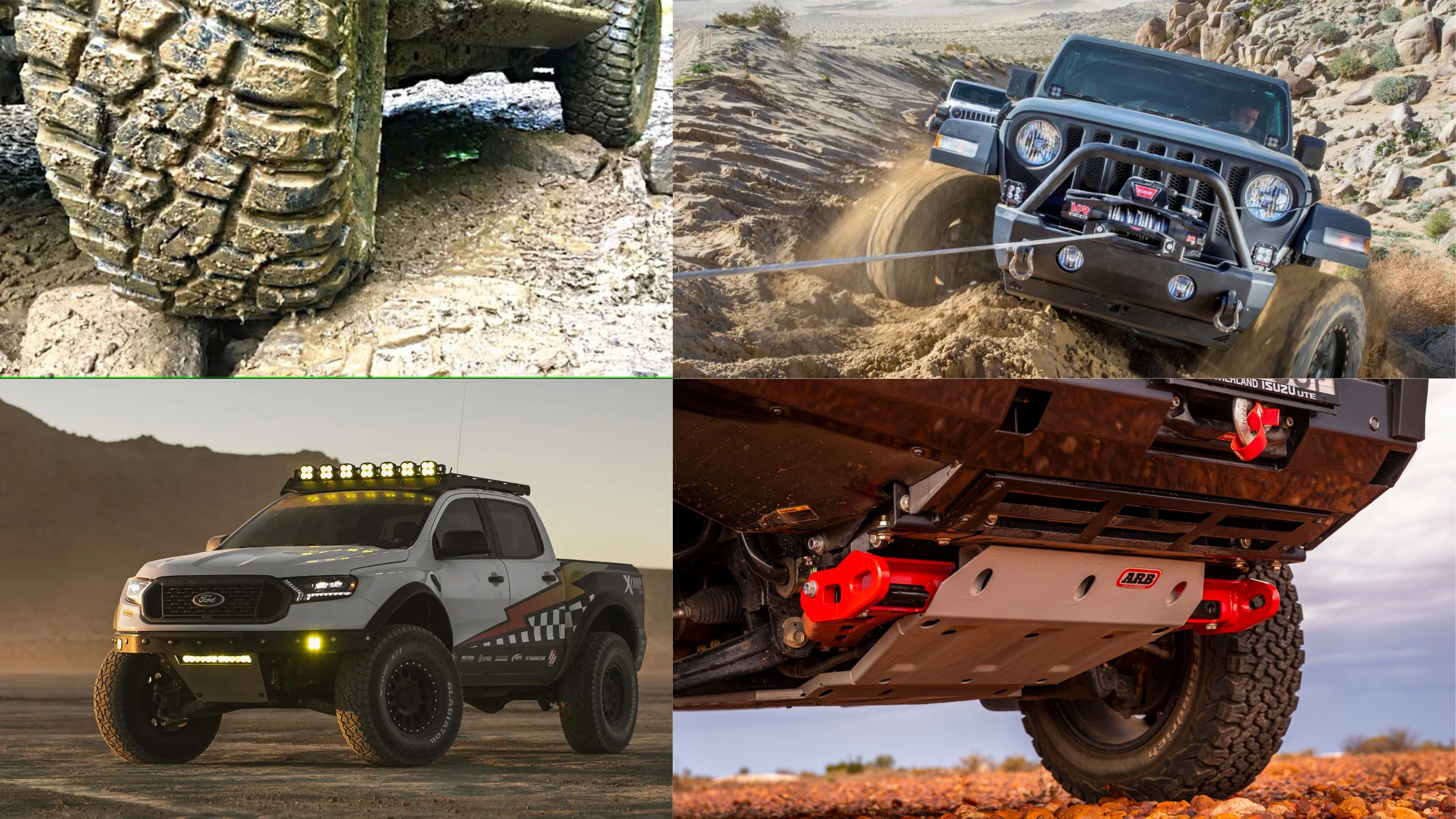Off-roading enthusiasts are constantly seeking ways to enhance their vehicles’ performance and capabilities for tackling challenging terrain. However, going through the complex world of vehicle modification laws can be just as daunting as conquering a rocky trail.
While regulations vary by state, certain off-road modifications generally remain legal across most of the United States, allowing adventure seekers to upgrade their rigs without running afoul of the law.
These modifications range from practical improvements that enhance safety and functionality to performance upgrades that help vehicles conquer difficult terrain. Understanding which modifications are widely accepted can save off-roaders from costly citations and legal troubles.
The following list explores ten off-road modifications that typically remain legal in most states, providing enthusiasts with options to enhance their vehicles while staying compliant with regulations.
Each modification serves a specific purpose in the off-roading experience, whether it’s improving visibility, increasing ground clearance, or enhancing traction in challenging conditions.
1. Lift Kits (Under 6 Inches)
Lift kits remain one of the most popular modifications for off-road enthusiasts, providing essential ground clearance for going through rough terrain. While regulations vary, most states permit moderate lift kits that raise a vehicle to six inches above its factory height.
These modifications allow vehicles to clear obstacles more effectively while maintaining reasonable stability and safety on public roads.
Body lifts use spacers between the frame and body to create clearance for larger tires without altering the suspension geometry.
Suspension lifts, meanwhile, replace factory components with taller springs, extended control arms, and longer shocks to increase both ground clearance and suspension travel.
The latter provides significant advantages in off-road scenarios by allowing wheels to articulate over obstacles while maintaining traction.
When installing a lift kit, it’s crucial to consider associated modifications. Proper alignment is essential after installation to prevent premature tire wear and ensure safe handling.
Extended brake lines may be necessary to accommodate the increased suspension travel, and some vehicles might require drive shaft modifications to prevent vibration at highway speeds.
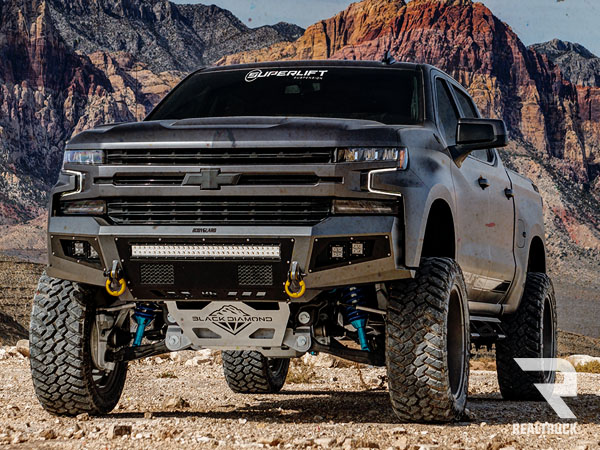
While most states accept moderate lifts, regulations typically require that headlights remain at the proper height and that bumpers stay within a certain distance from the ground.
Additionally, some states have restrictions on vehicle height, which may affect very tall modifications.
For daily drivers, a 2-4 inch lift often represents the sweet spot between off-road capability and on-road practicality, providing ample clearance without dramatically affecting handling characteristics or fuel economy.
Before installing a lift kit, consult local regulations and consider having the work performed by a professional shop familiar with both the technical aspects and legal requirements in your state.
2. All-Terrain and Mud Tires
All-terrain and mud tires represent a substantial yet legally sound upgrade for off-road enthusiasts across most states.
Unlike some modifications that face varying regulations, aftermarket tires remain largely unrestricted as long as they don’t extend beyond the vehicle’s fenders or significantly alter the vehicle’s width.
All-terrain tires offer a balanced compromise between off-road capability and on-road performance. Their moderately aggressive tread pattern provides enhanced traction on loose surfaces like gravel, sand, and light mud while maintaining reasonable road manners and acceptable noise levels for daily driving.
The interlocking tread design and reinforced sidewalls improve puncture resistance when traversing rocky terrain without sacrificing too much in terms of fuel economy or ride comfort.
Mud tires, with their more aggressive tread patterns and wider voids between lugs, excel in extremely challenging conditions like deep mud, snow, and loose sand.
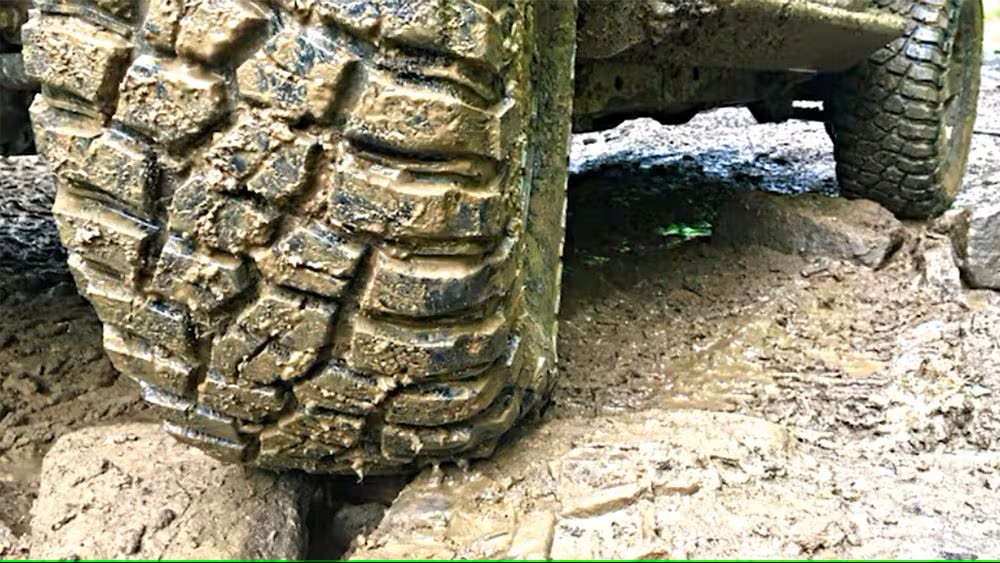
The self-cleaning design allows these tires to maintain traction by ejecting mud and debris as the tire rotates.
While these tires provide superior off-road performance, they typically generate more road noise, may cause vibration at highway speeds, and generally reduce fuel efficiency.
When selecting off-road tires, enthusiasts should consider load rating and ply construction. Many off-road specific tires feature reinforced sidewalls and additional plies to resist punctures and damage when running at lower air pressures a common technique for increasing traction in difficult terrain.
While tire modifications remain legal in most states, it’s important to ensure that tire coverage complies with local “mudflap laws” that require tires to be adequately covered to prevent debris from being thrown toward other vehicles.
Additionally, some states have noise regulations that could potentially affect extremely aggressive tread patterns.
Before purchasing, confirm that your tire selection falls within your vehicle’s recommended load range and consider how the added weight might affect braking performance and suspension components.
3. Winches and Recovery Equipment
Winches and recovery equipment stand as essential modifications for serious off-roaders, offering a crucial safety net when traversing challenging terrain.
Fortunately, these practical additions remain legal in virtually all states, making them a worry-free enhancement for adventure-seeking enthusiasts.
A properly installed winch provides self-recovery capability when a vehicle becomes stuck in mud, sand, or other obstacles. Most off-road winches feature electric motors powered by the vehicle’s electrical system, though hydraulic options exist for specialized applications.
The standard winch for recreational use typically offers between 8,000-12,000 pounds of pulling capacity, with the general recommendation being a winch rated for at least 1.5 times your vehicle’s gross weight.
Front bumper-mounted winches remain the most common configuration, requiring a winch-compatible bumper that properly distributes pulling forces to the vehicle’s frame.
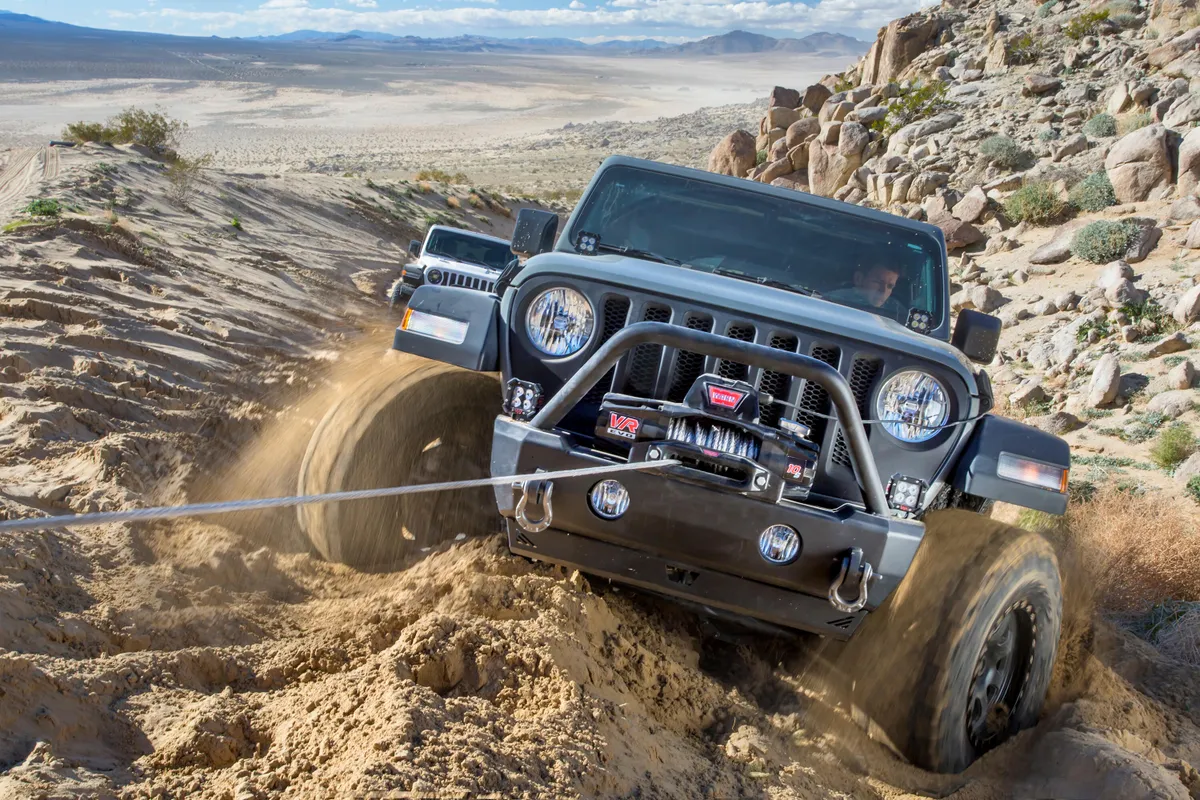
These specialized bumpers often incorporate additional features like shackle mounts, light brackets, and improved approach angles that benefit off-road performance.
Rear-mounted winches, while less common, provide additional recovery options and allow for pulling in multiple directions.
Beyond the winch itself, a comprehensive recovery kit typically includes synthetic winch ropes (lighter and safer than steel cables), tree trunk protectors, snatch blocks for changing pulling direction or increasing mechanical advantage, shackles, recovery straps, and gloves.
These accessories ensure safe winching operations under various conditions and help prevent damage to both the recovery equipment and the surrounding environment.
When installing a winch, proper electrical connections are critical. Heavy-gauge wiring and securely mounted solenoids prevent electrical fires and ensure reliable operation when needed most.
Additionally, practicing winching techniques before encountering real emergencies helps operators understand proper anchor selection, cable spooling, and the importance of using dampeners on tensioned lines.
While winches themselves face few legal restrictions, responsible use remains important. Recovery points should never be connected to tow balls or other components not designed for recovery forces, and winching operations should always prioritize safety by keeping bystanders clear of potential cable paths and using appropriate techniques.
4. Skid Plates and Underbody Protection
Skid plates and underbody protection represent one of the most practical and universally legal modifications for off-road vehicles.
These defensive installations shield vulnerable components from damage when going through the rough terrain, potentially saving thousands in repair costs while adding minimal regulatory complications.
Factory vehicles typically provide limited protection for vital components, leaving oil pans, transmission cases, transfer cases, differentials, and fuel tanks exposed to hazards like rocks, stumps, and high-centered terrain.
Aftermarket skid plates address this vulnerability by creating a protective barrier of hardened steel, aluminum, or composite materials that can slide over obstacles rather than catching and sustaining damage.
Steel skid plates offer maximum protection with their superior strength and ability to withstand repeated impacts without deformation.
Their drawback lies in added weight, which can affect fuel economy and handling. Aluminum alternatives provide a compelling middle ground, offering good protection at roughly half the weight of comparable steel components, though they may show more wear after significant impacts.
Ultra-high-molecular-weight polyethylene (UHMW) plastics provide lightweight options that excel at sliding over obstacles but offer less protection against sharp impacts.
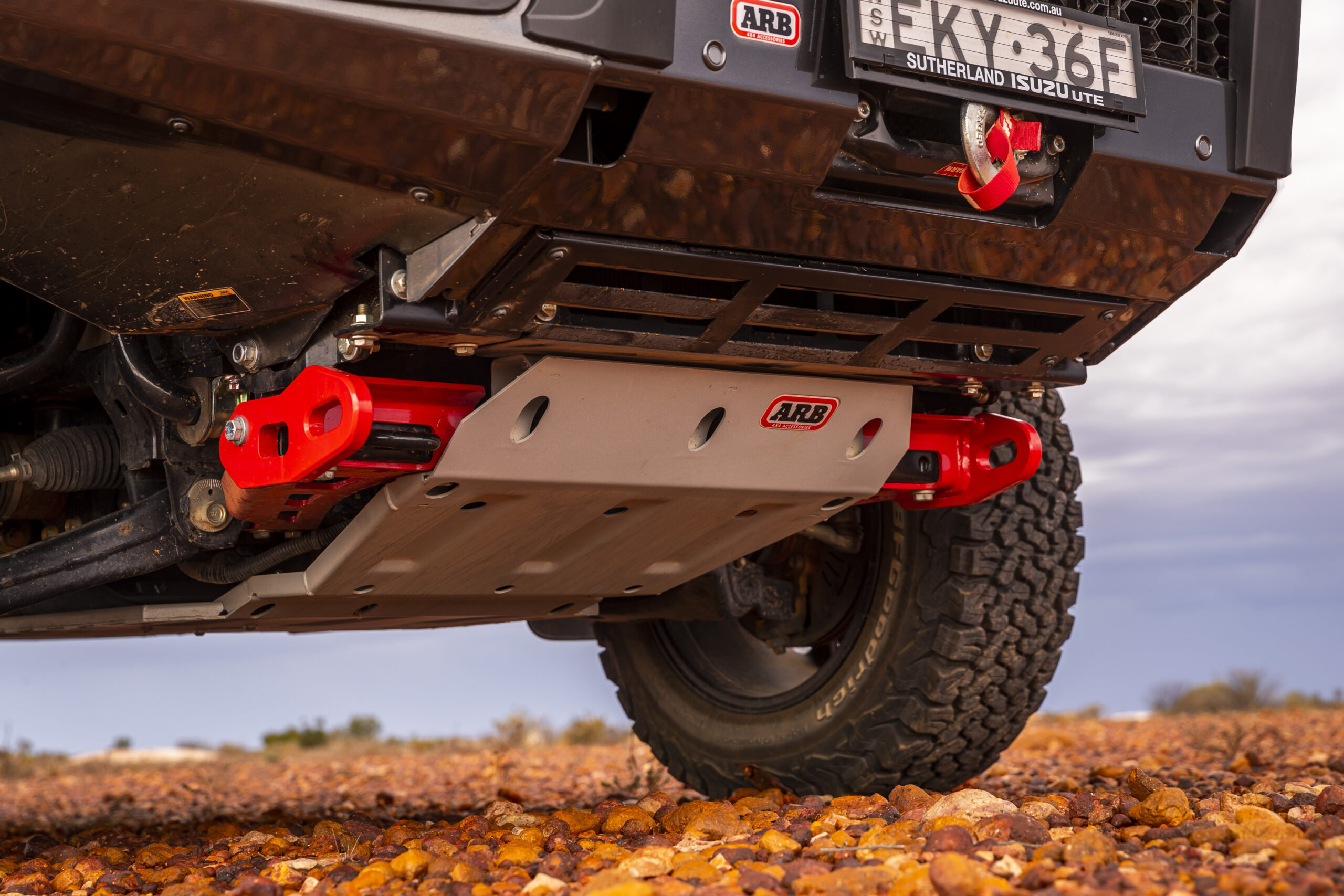
A comprehensive underbody protection system typically includes multiple components: front skid plates protecting the engine oil pan and steering components; transmission and transfer case skids covering the drivetrain; differential guards for front and rear axles; and fuel tank shields preventing punctures in remote locations. Many systems use a modular approach, allowing owners to replace individual sections if damaged rather than the entire assembly.
Beyond impact protection, quality skid plates incorporate thoughtful design elements including drain holes for water and mud, access ports for maintenance without removal, and angled leading edges that help the vehicle slide over obstacles rather than catching on them.
Some advanced designs even incorporate integrated jacking points for easier trail repairs. While these modifications remain legal nationwide, owners should ensure installation doesn’t interfere with emissions components or catalytic converters, as tampering with these systems could violate federal regulations.
Additionally, regular inspection of mounting hardware prevents skid plates from becoming loose a condition that could create dangerous road debris if components detach during travel.
Also Read: 10 American Muscle Cars Ideal for Weekend Track Days
5. Light Bars and Auxiliary Lighting
Auxiliary lighting systems represent one of the most popular off-road modifications, enhancing visibility during night trail navigation or in adverse weather conditions.
While legal in most states, these systems come with important regulatory considerations that vary by jurisdiction, particularly regarding on-road usage.
Modern LED light bars have revolutionized off-road illumination, offering unprecedented brightness, durability, and efficiency compared to traditional halogen options.
These lighting systems typically fall into several categories: flood beams provide wide-angle illumination ideal for low-speed trail navigation; spot beams project focused light over long distances for identifying obstacles on straightaways; and combination systems offer versatility for various conditions.
Additionally, specialized amber fog lights can dramatically improve visibility in dusty, foggy, or snowy conditions where white light might reflect toward the driver.
Mounting options include bumper installations, roof racks, pillar mounts, and grille integrations. Each position offers different advantages roof-mounted lights maximize distance visibility but may create hood glare, while lower bumper-mounted options produce less reflection but might have shorter projecting distances.
When installing multiple light sources, creating a balanced combination of nearby and distance illumination typically provides the most functional setup.
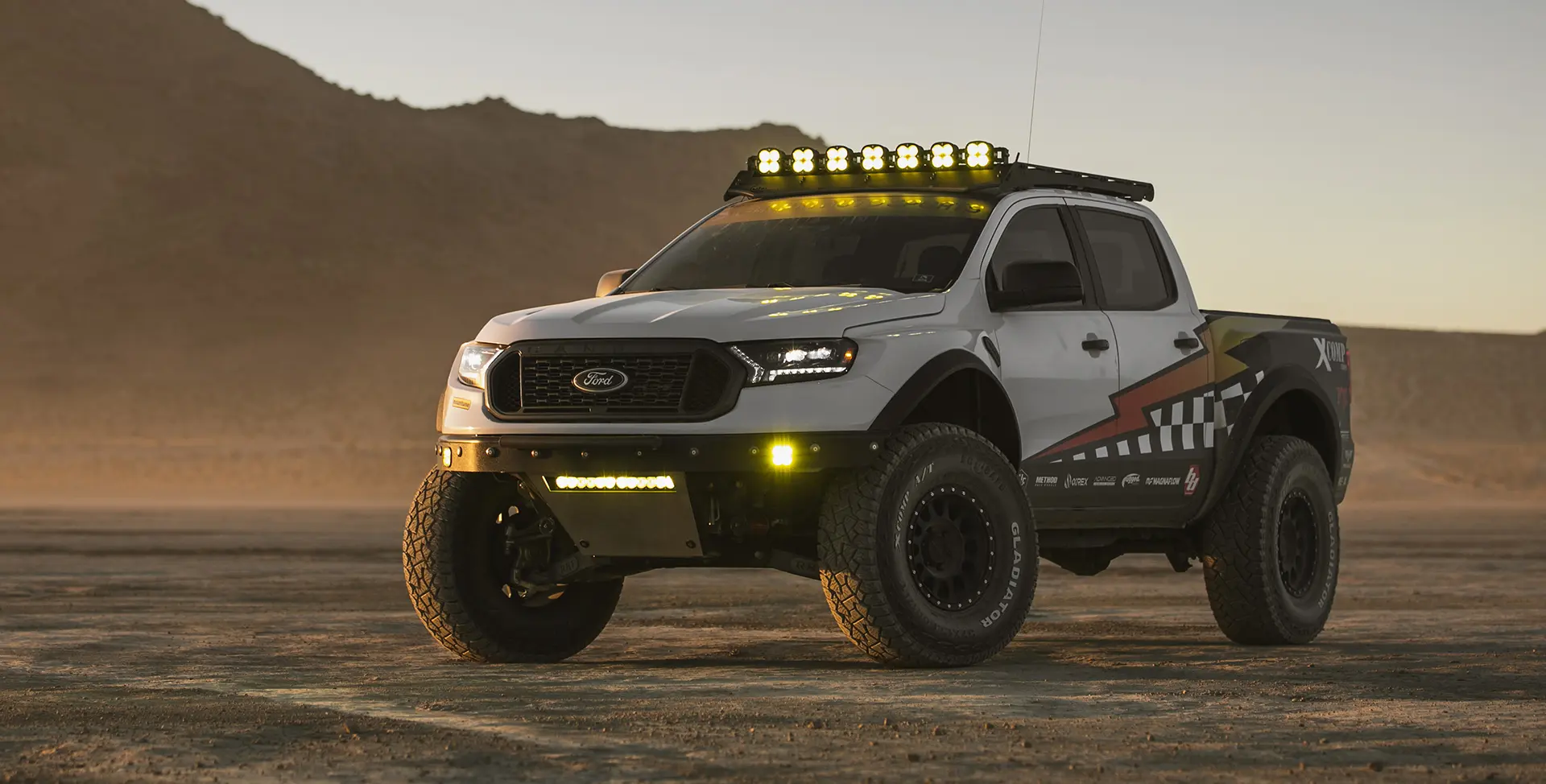
While auxiliary lighting itself is legal in all states, regulations governing on-road usage vary significantly.
Most jurisdictions require auxiliary forward-facing white lights to be covered when on public roads, and many have specific restrictions about colored lighting (particularly red and blue, which are reserved for emergency vehicles).
Some states limit the total number of forward-facing lights, their maximum brightness, or their mounting height.
Proper wiring represents another critical consideration, as high-output lighting systems draw substantial current.
Professional-grade installations typically include dedicated relays, appropriate circuit protection, and heavy-gauge wiring to prevent electrical fires or vehicle system damage. Wiring should be properly secured, protected from abrasion, and kept away from high-heat components.
For those seeking street-legal auxiliary lighting, SAE-compliant fog lights or driving lights mounted below the headlight height often represent the most universally accepted options.
These standardized lights meet specific beam pattern requirements designed to minimize glare for oncoming drivers while still providing useful illumination.
Whatever option you choose, installing a dedicated switch that prevents accidental activation of off-road lighting during street use helps avoid unintentional traffic violations.
6. Snorkels and Raised Air Intakes
Snorkels and raised air intakes represent a practical modification that enhances a vehicle’s off-road capability while remaining legal in virtually all states.
These systems relocate the engine’s air intake point to a higher position, typically near roof level, providing significant advantages in certain off-road scenarios.
The primary benefit of a snorkel system comes during water crossings, where it prevents hydrolocking a potentially catastrophic condition where water enters the engine’s combustion chambers, causing immediate mechanical failure.
By raising the air intake above the hood level, these systems allow vehicles to go through significantly deeper water crossings than factory designs permit.
However, it’s crucial to understand that a snorkel alone doesn’t make a vehicle fully amphibious; electrical components, differentials, and transmissions still have their ventilation requirements and depth limitations.
Beyond water protection, snorkels offer substantial benefits in dusty conditions. By drawing air from above the vehicle rather than from the wheel wells or behind the grille, these systems access cleaner air above the dust cloud that typically surrounds vehicles on unpaved roads.
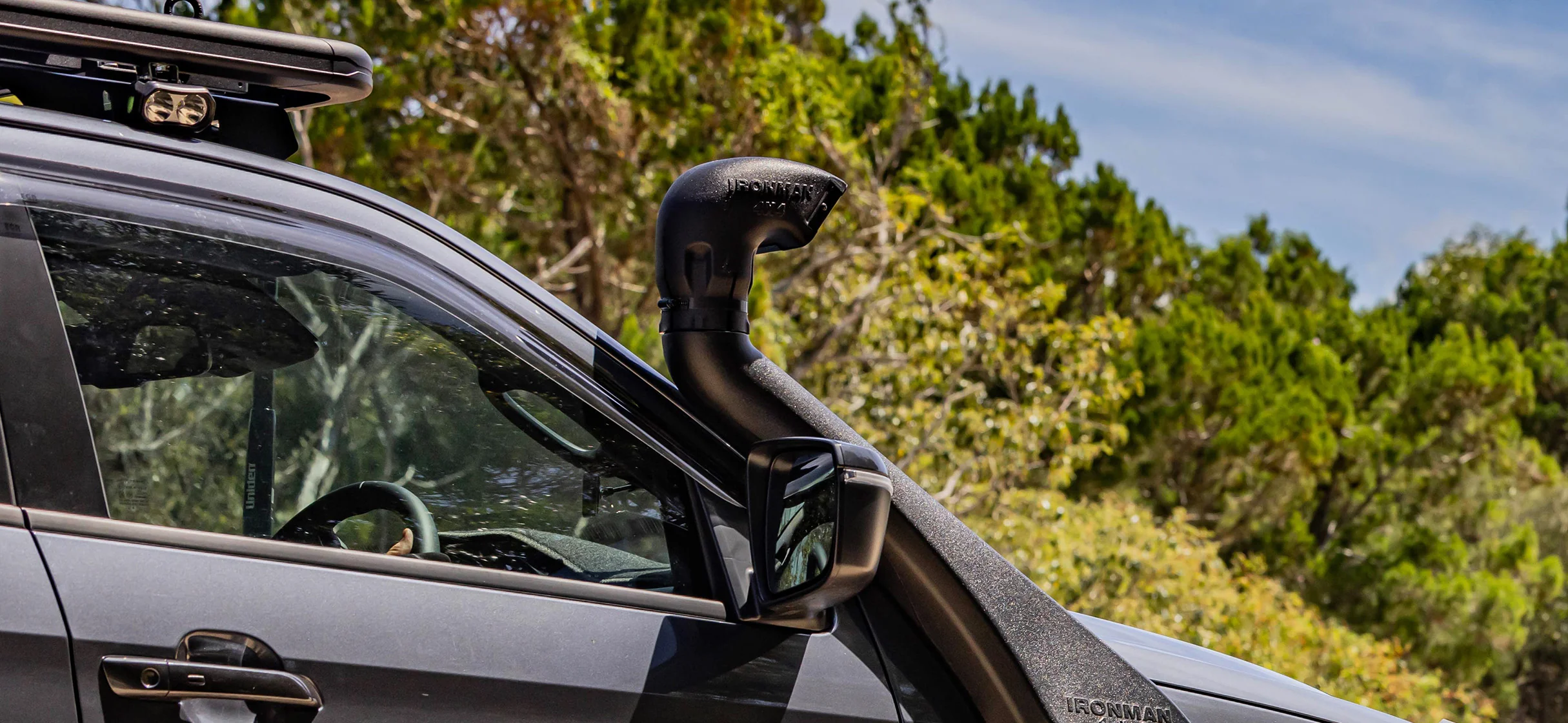
This reduced dust intake extends air filter life and maintains optimal engine performance during extended off-road travel, particularly when following other vehicles on dirt roads.
Quality snorkel systems incorporate several key design elements: water-separating technology that removes moisture from incoming air before it reaches the filter; pre-filters that trap larger dust particles; and ram-air designs that slightly pressurize the intake system at highway speeds, potentially improving engine efficiency.
Installation typically requires cutting a hole in the vehicle’s fender for mounting, making professional installation worth considering for those uncomfortable with such modifications.
From a legal perspective, snorkels face few restrictions in most jurisdictions provided they don’t extend beyond the vehicle’s width or create unsafe protrusions.
Their growing popularity among overlanding enthusiasts has led to improved designs that complement various vehicle aesthetics rather than appearing as utilitarian afterthoughts.
When considering a snorkel installation, it’s worth noting that many manufacturers offer vehicle-specific kits that maintain proper airflow characteristics and ensure compatibility with factory engine management systems.
While universal kits exist, they often require more extensive modification and may not provide optimal performance for specific engine designs.
7. Rock Sliders and Side Steps
Rock sliders represent one of the most functional protective modifications for off-road vehicles, offering crucial body protection while remaining legal across all states.
Unlike some aesthetic modifications that face varying regulations, these practical additions typically raise no legal concerns when properly installed.
True rock sliders differ significantly from factory sidesteps or running boards, which primarily facilitate easier vehicle entry and exit. Purpose-built sliders mount directly to the vehicle’s frame rather than the body, creating a rigid protective structure that can bear the entire vehicle’s weight during extreme off-camber situations.
This frame-mounting approach transfers impact forces directly to the strongest part of the vehicle, preventing body damage when sliding across rocks, logs, or other trail obstacles.
Construction materials play a crucial role in slider effectiveness. Heavy-wall steel tubing (typically 1.75″ to 2″ diameter with .120″ to .250″ wall thickness) provides maximum protection at the cost of added weight.
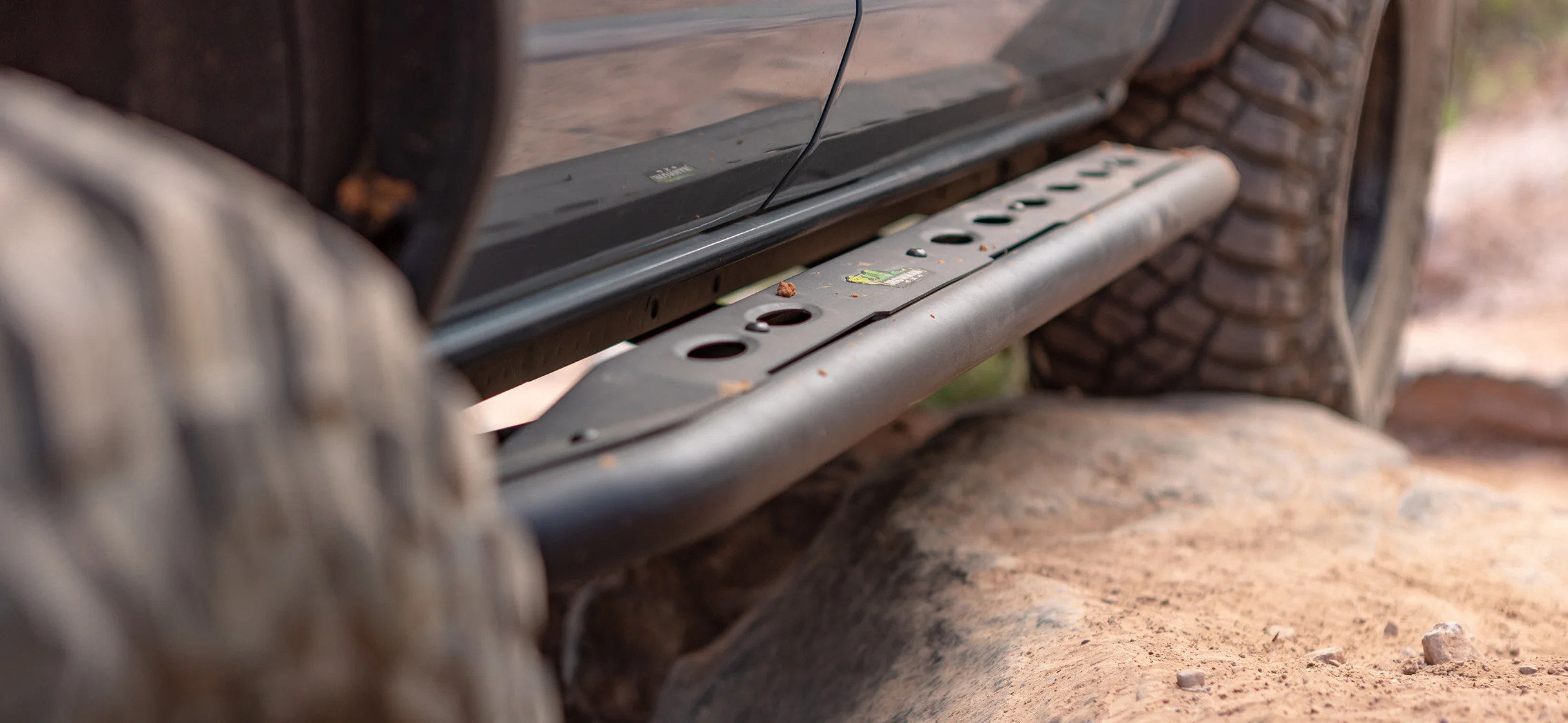
DOM (drawn over mandrel) tubing offers superior strength compared to standard ERW (electric resistance welded) options, though at a higher cost.
For those seeking lighter alternatives, aluminum sliders provide good protection with less weight penalty, though they may show more cosmetic damage after impacts than their steel counterparts.
Design features vary among manufacturers, with some emphasizing body protection through plate-style designs that shield door panels from brush and debris.
Others focus on functional rock crawling aids with angled surfaces that help vehicles slide over obstacles rather than hanging up on them. Advanced designs often incorporate jacking points for trail repairs, and some feature integrated steps without compromising structural integrity.
When selecting rock sliders, vehicle-specific designs offer superior fitment and protection compared to universal options. Proper installation remains critical, with high-grade hardware and careful torquing procedures preventing loosening during the substantial vibration experienced in off-road conditions.
While installation can be performed by knowledgeable enthusiasts, the critical nature of proper mounting makes professional installation worth considering.
Beyond their protective function, quality rock sliders often enhance a vehicle’s approach and departure angles by tucking tightly against the body, eliminating the low-hanging protrusions found with factory running boards.
This improved clearance allows vehicles to go through the obstacles more effectively while maintaining essential protection for vulnerable rocker panels and door sills that would otherwise be susceptible to costly damage.
8. Upgraded Suspension Components
Upgraded suspension components represent one of the most transformative yet legally acceptable modifications for off-road vehicles.
While extreme modifications may face restrictions, moderate suspension upgrades remain legal in most states when properly installed and maintained within reasonable parameters.
Beyond simple lift kits, comprehensive suspension upgrades focus on improving a vehicle’s articulation, durability, and control in challenging terrain.
Heavy-duty shock absorbers stand as the foundation of these improvements, with premium monotube designs offering superior heat dissipation and consistent damping during extended off-road sessions.
Advanced remote-reservoir shocks take this further by separating oil and nitrogen chambers, preventing the performance-robbing suspension fade that occurs when conventional shocks overheat during rapid compression cycles.
Control arms and links represent another critical upgrade area, with aftermarket components typically offering adjustability for proper alignment after lifting and enhanced durability through stronger materials and serviceable bushings.
Extended-length control arms improve articulation by allowing greater wheel travel while maintaining proper geometry, while heavy-duty track bars and steering stabilizers improve directional control when going through obstacles at challenging angles.
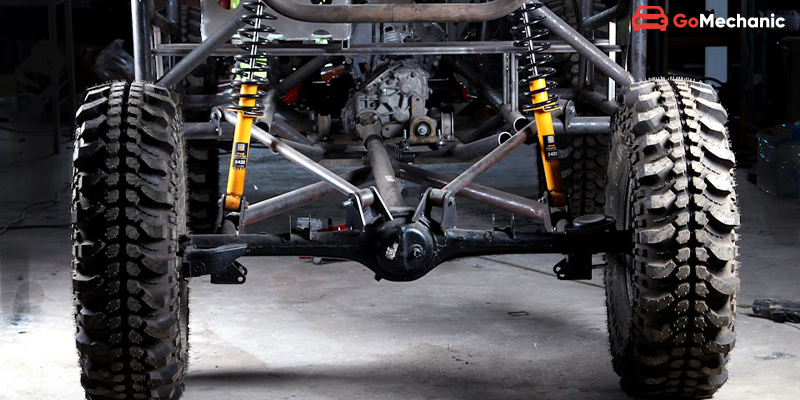
Bushings and mounting hardware, often overlooked during basic modifications, play crucial roles in long-term suspension performance. Polyurethane bushings offer enhanced responsiveness and durability compared to rubber, though they may transmit more vibration.
Meanwhile, high-grade mounting hardware with appropriate torque specifications prevents the loosening that can lead to dangerous failures during off-road stress.
For vehicles facing extreme conditions, specialized components like bypass shocks, coilovers, and air-bump systems offer position-sensitive damping that can be tuned for specific terrain types.
These advanced systems provide progressive resistance that remains comfortable during light articulation but firms up to prevent bottoming out during substantial impacts.
From a legal perspective, most suspension modifications remain acceptable provided they don’t create unsafe conditions like extreme instability, inadequate braking ability, or improper headlight aiming.
However, some states do impose specific limits on suspension lift heights or require recertification of significantly modified vehicles. Professional installation with proper attention to brake line length, driveshaft angles, and steering geometry helps ensure both safety and legality.
One often overlooked consideration involves load-carrying capability. When selecting upgraded suspension, components should match the vehicle’s intended use whether that’s high-speed desert running, technical rock crawling, or expedition travel with substantial gear weight.
Understanding these distinctions helps owners select appropriate spring rates and damping characteristics that maintain control under their specific loading conditions.
9. Performance Air Filters and Intake Systems
Performance air filters and intake systems represent one of the most accessible yet effective modifications for off-road vehicles, offering potential improvements in engine response, power, and dust protection.
These upgrades generally remain legal in most states when properly selected and installed, though emissions considerations require attention in certain jurisdictions.
Factory air intake systems prioritize noise suppression and manufacturing cost over optimal airflow, creating an opportunity for performance enhancement through aftermarket solutions.
Cold air intake systems relocate the filter to access cooler, denser air from outside the hot engine compartment, potentially increasing horsepower and torque.
These systems typically feature smoother, less restrictive tubing that reduces turbulence and improves airflow to the engine, especially at higher RPMs.
Filter technology itself offers significant variation among aftermarket options. Traditional paper filters provide adequate filtration but restrict airflow and require frequent replacement in dusty conditions.
Cotton-gauze oiled filters from companies like K&N and S&B offer washable, reusable alternatives that typically flow better than paper while maintaining reasonable filtration efficiency.
For extreme dust environments, specialized dry filters using synthetic media provide the best protection, though potentially with more flow restriction.
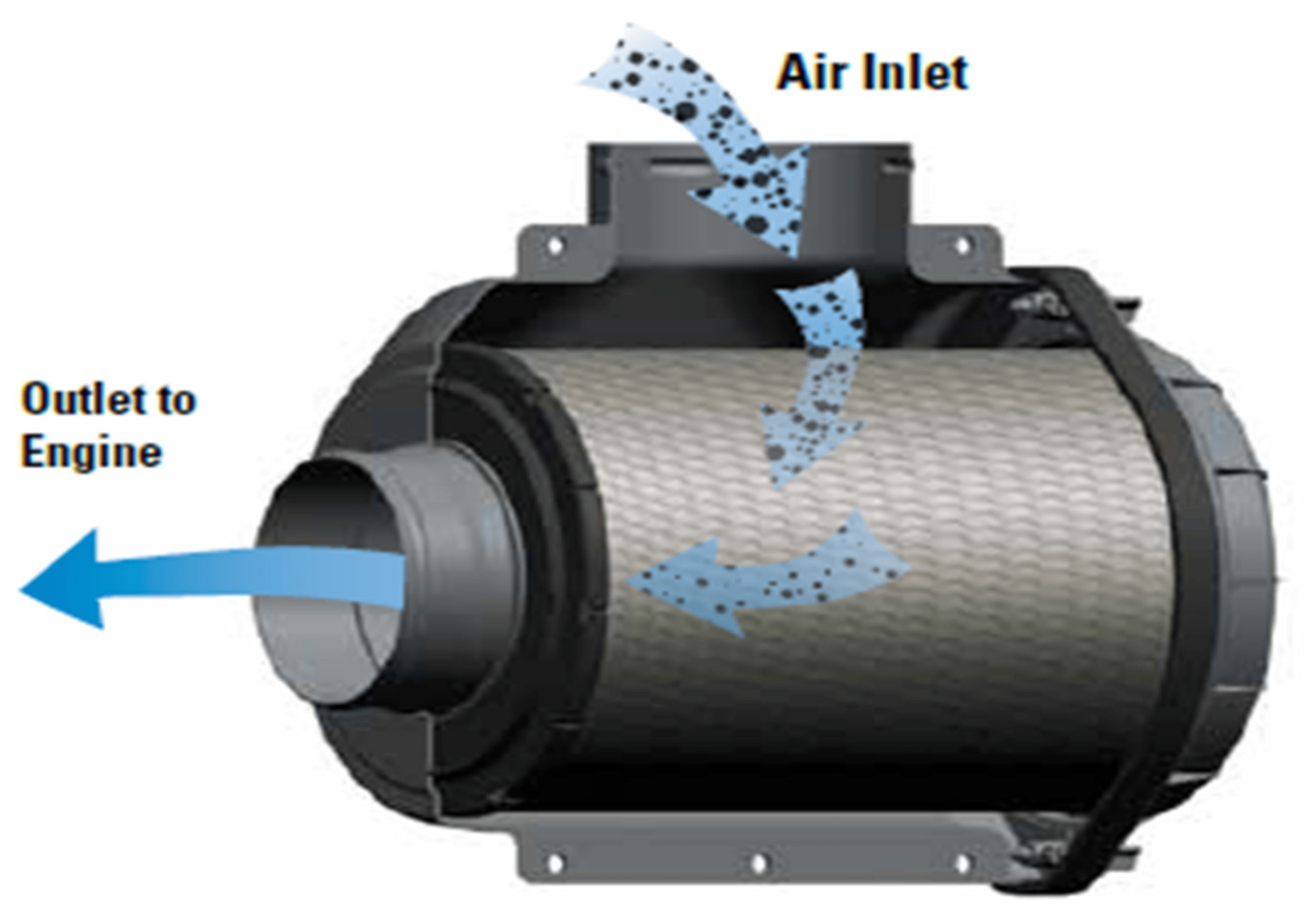
Designing for off-road use introduces considerations beyond simple performance. Effective water and dust protection become crucial, with some systems incorporating pre-filters, water-resistant filter media, and protective housings that shield the main filter element from direct exposure to mud splashes or water crossings.
The most comprehensive systems feature multiple stages of filtration, trapping larger particles before they reach the main filter element.
From a legal perspective, intake modifications generally remain acceptable in most states provided they don’t tamper with emissions equipment.
However, California and states following CARB (California Air Resources Board) standards require intakes to carry Executive Orders (E.O. numbers) certifying they don’t adversely affect emissions performance.
These certifications involve extensive testing and ensure the systems maintain proper air-fuel ratios across all operating conditions.
Professional tuning represents an important consideration when significantly changing airflow characteristics. Modern vehicles use sophisticated engine management systems that measure incoming air and adjust fuel delivery accordingly.
While minor intake modifications typically remain within the adaptation range of factory computers, substantial changes may benefit from custom tuning to optimize performance and prevent potential running issues.
For those using their vehicles in varied environments, some manufacturers offer modular intake systems that can be configured differently based on conditions using maximum flow settings for normal driving while quickly converting to maximum protection modes for extreme dust or water crossings.
10. Differential Lockers and Limited-Slip Differentials
Differential lockers and limited-slip differentials represent some of the most transformative yet legally acceptable modifications for serious off-road enthusiasts.
These traction-enhancing components dramatically improve a vehicle’s ability to go through challenging terrain while remaining compliant with regulations in virtually all states.
Standard open differentials found in most factory vehicles permit wheels to rotate at different speeds during turns, but this design inadvertently sends power to the path of least resistance typically the wheel with the least traction.
This limitation becomes particularly problematic in off-road scenarios where one wheel may lose contact with the ground or encounter slippery surfaces, effectively halting forward progress despite other wheels having available traction.
Locking differentials address this limitation by mechanically connecting both wheels on an axle, forcing them to rotate at identical speeds regardless of traction differences.
Selectable lockers allow drivers to engage this feature on demand locking for difficult terrain and unlocking for normal driving to maintain on-road handling characteristics.
Automatic lockers, meanwhile, engage when traction differences are detected and disengage during turns, offering convenience at the expense of some unpredictability in handling.
Limited-slip differentials (LSDs) provide a middle ground between open and locked systems. Rather than fully locking, these units transfer some power to the wheel with better traction through either clutch mechanisms or helical gears.
This compromise maintains reasonable on-road manners while providing moderate traction improvements off-road. Torsen-type LSDs use worm gears to sense torque differences and redirect power accordingly, while clutch-type units use friction materials to transfer torque between wheels.
Installation considerations vary by system type. Electronic lockers require additional wiring and switches but offer convenient operation. Air lockers provide reliable performance but necessitate compressors and air lines.
Mechanical systems offer simplicity but may require more driver techniques to engage properly. All systems benefit from professional installation to ensure proper break-in procedures and gear preload settings.
From a legal perspective, these modifications remain widely accepted provided they don’t adversely affect on-road handling safety.
However, some extremely aggressive automatic lockers may create unpredictable handling during emergency maneuvers on pavement, potentially raising safety concerns. Selectable systems avoid this issue by allowing drivers to run open differentials during normal driving.
When considering differential modifications, it’s worth noting that front and rear installations offer different advantages. Rear lockers provide the most noticeable improvement for climbing obstacles while maintaining steering predictability.
Front lockers add tremendous capability but require more technique to manage effectively, particularly in maintaining steering control when engaged on varied surfaces.
Also Read: 12 Cars With Driver Monitoring Systems for Safer Commutes

